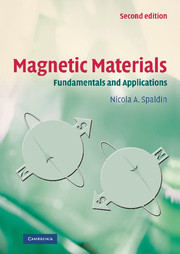Book contents
- Frontmatter
- Contents
- Acknowledgments
- I Basics
- 1 Review of basic magnetostatics
- 2 Magnetization and magnetic materials
- 3 Atomic origins of magnetism
- 4 Diamagnetism
- 5 Paramagnetism
- 6 Interactions in ferromagnetic materials
- 7 Ferromagnetic domains
- 8 Antiferromagnetism
- 9 Ferrimagnetism
- 10 Summary of basics
- II Magnetic phenomena
- III Device applications and novel materials
- Epilogue
- Solutions to selected exercises
- References
- Index
3 - Atomic origins of magnetism
from I - Basics
Published online by Cambridge University Press: 05 June 2012
- Frontmatter
- Contents
- Acknowledgments
- I Basics
- 1 Review of basic magnetostatics
- 2 Magnetization and magnetic materials
- 3 Atomic origins of magnetism
- 4 Diamagnetism
- 5 Paramagnetism
- 6 Interactions in ferromagnetic materials
- 7 Ferromagnetic domains
- 8 Antiferromagnetism
- 9 Ferrimagnetism
- 10 Summary of basics
- II Magnetic phenomena
- III Device applications and novel materials
- Epilogue
- Solutions to selected exercises
- References
- Index
Summary
Only in a few cases have results of direct chemical interest been obtained by the accurate solution of the Schrödinger equation.
Linus Pauling, The Nature of the Chemical Bond, 1960The purpose of this chapter is to understand the origin of the magnetic dipole moment of free atoms. We will make the link between Ampère's ideas about circulating currents, and the electronic structure of atoms. We'll see that it is the angular momenta of the electrons in atoms which correspond to Ampère's circulating currents and give rise to the magnetic dipole moment.
In fact we will see that the magnetic moment of a free atom in the absence of a magnetic field consists of two contributions. First is the orbital angular momenta of the electrons circulating the nucleus. In addition each electron has an extra contribution to its magnetic moment arising from its “spin.” The spin and orbital angular momenta combine to produce the observed magnetic moment.
By the end of this chapter we will understand some of the quantum mechanics which explains why some isolated atoms have a permanent magnetic dipole moment and others do not. We will develop some rules for determining the magnitudes of these dipole moments. Later in the book we will look at what happens to these dipole moments when we combine the atoms into molecules and solids.
- Type
- Chapter
- Information
- Magnetic MaterialsFundamentals and Applications, pp. 22 - 37Publisher: Cambridge University PressPrint publication year: 2010



